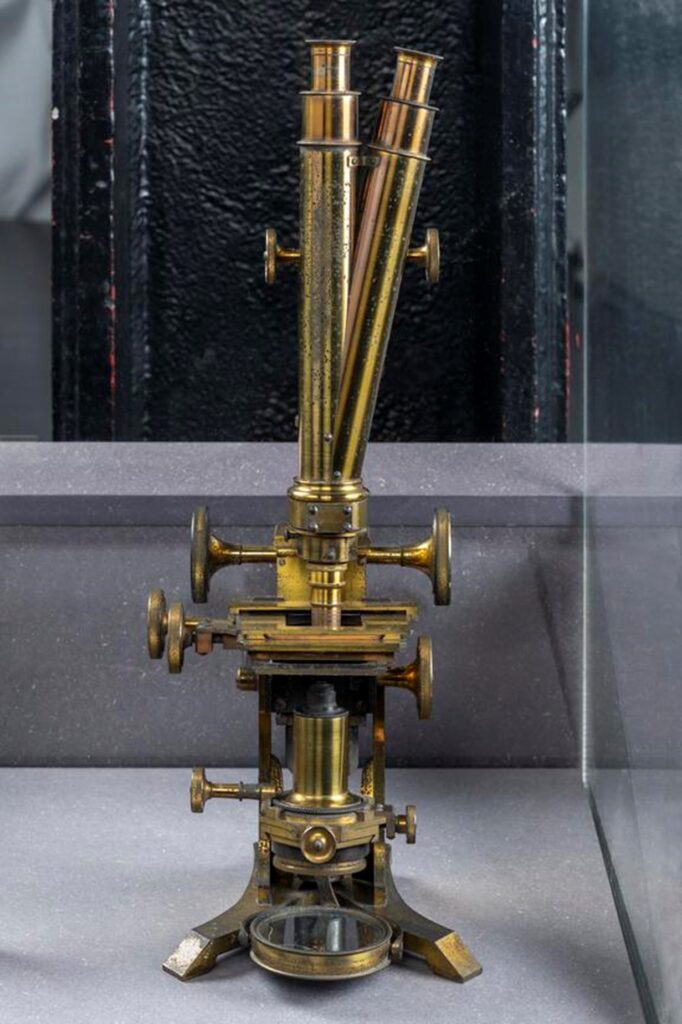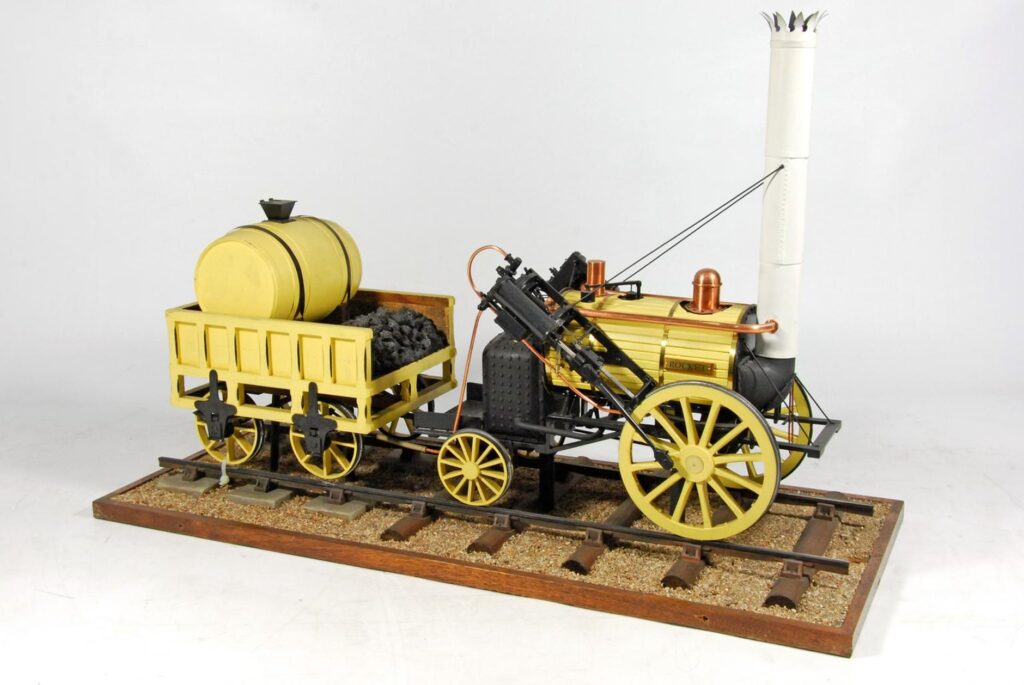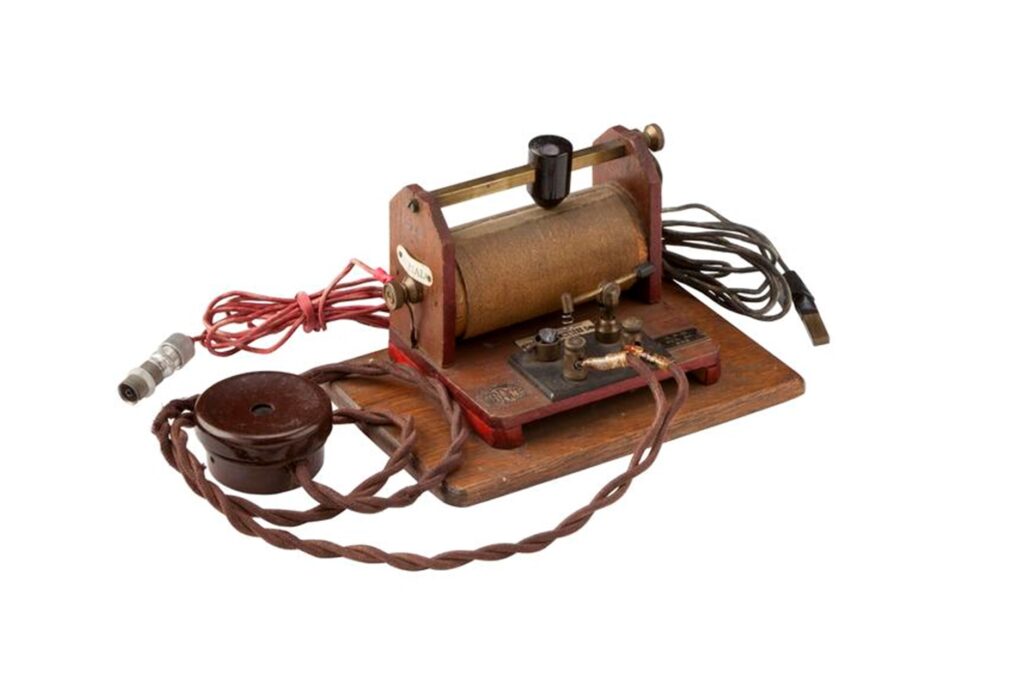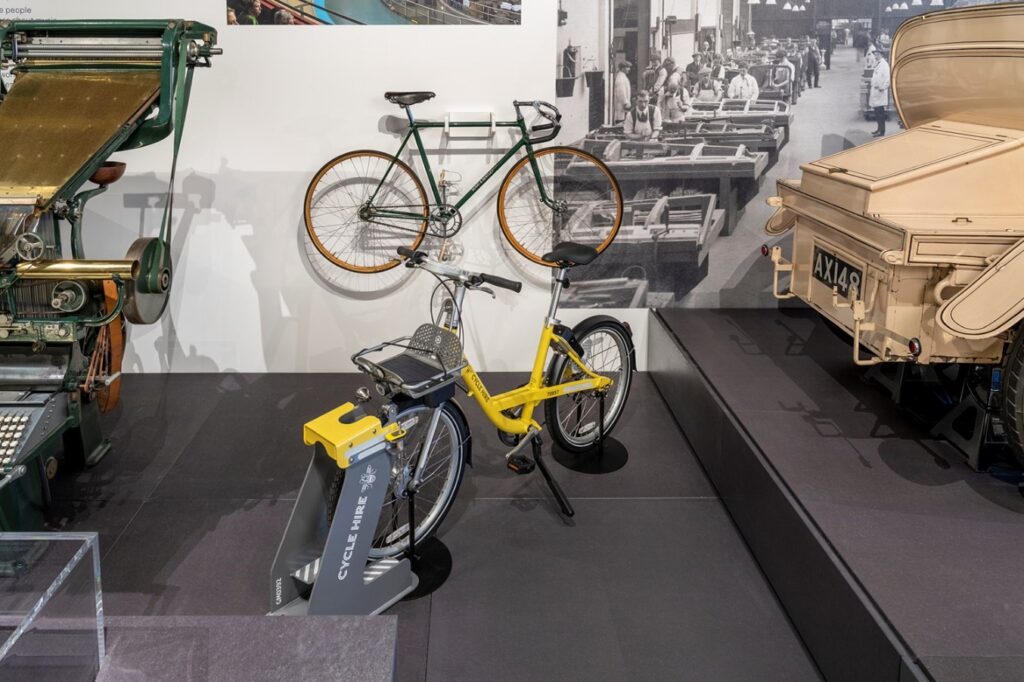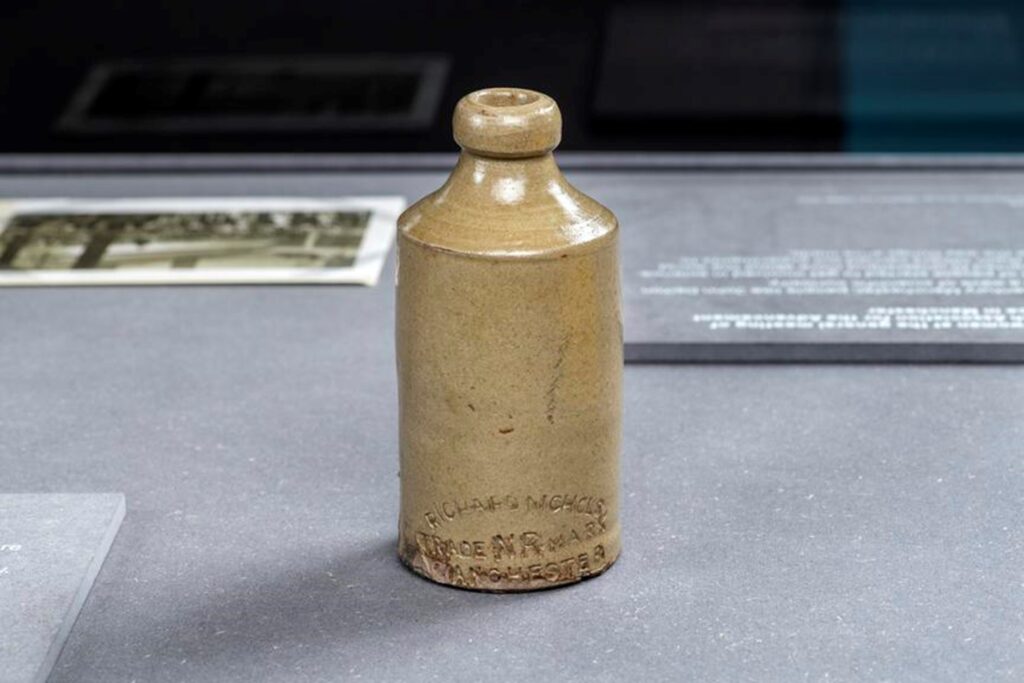Wondering what to get for the person who has everything?
Our curatorial colleagues have come together to create a list of gift ideas and Christmas essentials influenced by some of the wonderful objects on display in our Revolution Manchester Gallery.
- An Acorn BBC Microcomputer – just what every 1980s child wanted!
Top of many Christmas lists in the 1980s was a home computer, like this Acorn BBC Micro. In the 1980s there was home computer boom in Britain as millions of people bought their first computer: machines like the Acorn , the Sinclair Spectrum, Dragon 32 and Amstrad CPC464. So popular were these electronic marvels that there were shortages at Christmas, and Britain soon had more home computers per person than anywhere else in the world.
Parents bought these futuristic machines for their children in the hope that they would teach them about computers. However, many of those children quickly realised that they were far more fun for playing games on. Christmas afternoons, now lit up by the colourful graphics and electronic sounds of the latest video games – many from Manchester-based companies – would never be the same again.
- A microscope – the ideal present to inspire a young scientist!
Being able to see the smallest things seems perfectly possible today, however, this wasn’t always the case. Though the desire to see what is invisible to the human eye is thousands of years old. Microscopy, the science of examining the small with the aid of glasses, dates to the 13th century. The first models usually involved magnifying glasses, but as the science of optics developed, so did microscopes.
However, it was not only adults who enjoyed the wonders of seeing the small. Toy microscopes intended for children follow pretty quickly after their professional counterparts. For example, this Nuremburg Culpeper-type microscope dating from the 1830s, or Continental microscope from the mid-1800s, were developed to spark children’s interest in science. Would you like to receive a microscope as a Christmas gift? What small things would you look at?
- A sticky tape dispenser – essential for wrapping presents and doing science.
Are you an expert present-wrapper? Or do you end up tangled in paper and sticky tape? Whether you love it or hate it, wrapping presents is often part of the festive ritual, and you can’t wrap presents without sticky tape.
This, however, isn’t just any old sticky tape dispenser. In 2004 scientists at the University of Manchester had the bright idea to try peeling apart layers of graphite using bog standard sticky tape. This is the very roll that was used to first isolate atomically thin layers of wonder material graphene, an experiment that led to the Nobel Prize in Physics in 2010. So if you’re wrapping presents this year, consider that you’re using a piece of Nobel Prize-winning equipment every time you stick a bit of paper down.
- A Model of Stephenson’s Rocket – perfect for running around a Christmas tree.
The Science and Industry Museum is home to the world’s oldest surviving passenger railway station and a collection of historic locomotives, but if you don’t have room for a full-size train you could always get a model like this miniature Stephenson’s Rocket or a trainset.
Early model trains were advertising tools or expensive works of miniature engineering for the wealthy. From the 1920s, mass produced and cleverly marketed trainsets from companies like Hornby became very popular for children. Made of tinplate and powered by clockwork, or sometimes hazardously high-voltage electricity, these were fairly crude toys. However, the introduction of diecast models in the 1930s, then new plastic materials from the 1940s, allowed for highly detailed models that were more faithful to the originals.
The trainset market boomed in the mid-20th century, with sales reaching a peak in 1961. Is a trainset on your Christmas list this year?
- A 1920s ‘Cat’s whisker’ Crystal Radio – so you can listen to the King’s Christmas speech, when it starts, a few years after this wireless set was actually made…
If you were lucky enough to receive a new radio for Christmas in 1925, you would have been guaranteed some entertainment over the festive period, as just a few years previously in 1922, the BBC officially launched its first radio programme schedule. Radio enthusiasts in Manchester could enjoy listening to a selected programme from 2ZY, one of the first radio stations in the UK. It was managed by in Trafford Park, which was a founding company in the original BBC consortium.
People listening to Manchester 2ZY on Christmas Eve in 1925 could hear the Rev J Shepherd deliver “Christmas Eve in Summertime”, followed by the Manchester Station Comedy Company presenting “Ali Baba.” Programmes were specially chosen for regional audiences and blended in with the central London programme. The Radio Times magazine started in 1922 at the same time as the BBC to provide a guide to radio programmes across the UK. The first issue on 30th September proudly tells of how there was over 1,700 distinct evening programmes in the year leading up to the BBC’s official launch. Radio was taking off!
Tuning in to the Royal Christmas Message is still a Christmas tradition for many. In 1932, radio listeners could tune into the first Royal Christmas speech, delivered by George V and broadcast across the British Empire. You can read more about royal radio broadcasts in this blog from the National Science and Media Museum. The Cat’s Whisker radio set above has one headphone, meaning it would mostly be for solo listening, but before long radio sets would become more central in people’s homes, with families listening in together to a broad variety of regional programming.
- A Jacquard loom – perfect for weaving patterned Christmas jumpers.
Fashionably unfashionable, the Christmas jumper is a modern Christmas tradition. Colourful, winter-patterned knitwear probably originated in Scandinavia, but it’s only in recent decades that the Christmas jumper became a cultural phenomenon in Britain, as people started seeing them as funny novelty items.
While people can make Christmas jumpers themselves, all those patterns of snowflakes, trees, Santas and other festive fun are tricky to knit by hand. Most Christmas jumpers are mass produced by clever machines programmed to quickly create these intricate patterns.
The earliest successful machine that could mass produce patterned fabric was the Jacquard Loom, developed around 1800 by Joseph Marie Jacquard. By using a mechanical chain of cards with holes punched in them to control which threads were included in the weave, the Jacquard Loom could quickly produce patterned cloth. Different decks of punched cards could be used to print different patterns. Today’s Christmas jumper knitting machines are computerised, but they owe a historic debt to the Jacquard Loom.
- A Bicycle – A bike is not just for Christmas, it is for sustainable travel all year round.
Whether it was your first sit-on toy trike or that trendy Raleigh Chopper that made you the envy of all your childhood friends, many people’s most memorable Christmas gift was a bike.
If you were in Manchester looking to pick up the latest design in pedal power in the 1890s, you wouldn’t have had to go far. You could get a top-of-the-range Lu-Min-Um from a bike shop on St Mary’s Gate, just off Deansgate. By 1900 around 190 “Bicycle Manufacturers, Dealers and Agents” were listed in the local Manchester trade directories.
In the 1930s, you would have needed to plan ahead if wanted to put a sleek world-class Johnny Berry bike under your Christmas tree. The Manchester-based bike frame builder had a waiting list of up to two years.
You may not be able to stretch to a new bike this year, but you can still enjoy the ever-more cycle-friendly streets of Manchester by using a Bee Network hire bike to do your Christmas shopping. Or you could gift someone a taster session at the National Cycling Centre and follow in the pedals of many great Manchester cycle heroes, including Wilf Higgins, Dame Sarah Storey and Withington-born BMX superstar, Charlotte Worthington. With Manchester having been named the first ever European Capital of Cycling, 2024 will be an especially good time to get on your bike.
- Beer – An important part of the festivities for some.
Whether it’s a work Christmas party or a pint with friends on Boxing Day, for some of the grown-ups a frothy pint is part of their Christmas festivities. Perfecting a pint is of course a science and an art. We learn in school that James Joule’s laws of thermodynamics laid the foundations of modern science, but did you know he took inspiration from his day job running his family brewery in Salford? In the 1840s, he began investigating different ways to power his brewing equipment, which ultimately led to him revolutionising .
Manchester’s hoppy history doesn’t end there. Boddingtons, J.W. Lees, Joseph Holt’s, Hydes, and Robinsons are traditional local choices. Nowadays Manchester has a thriving craft beer scene and micro brewers take the science of their craft very seriously. So if a festive tipple is your thing, someone might treat you to some trendy ales.
- Chocolate – which science makes even better.
What would Christmas be without all the chocolate? Hiding in your advent calendar, covering your biscuits, or melting in a hot cup, chocolate is a Christmas staple.
Brought from Mesoamerica by Christopher Columbus in the 16th century, chocolate was not immediately popular. There are registers that Spanish people mixed the cacao with spices such as cinnamon and aniseed, while the British mixed it with sugar and eggs. However, it wasn’t until the 19th century that chocolate became readily available, and palatable, to all. First enjoyed by many as a drink, Fry’s of Bristol produced the first chocolate bar in 1847, followed by Cadbury’s in 1849. Another big development happened in 1905 when Cadbury introduced the first milk chocolate bar, which proved tremendously popular. Since then, hundreds of flavours and shapes have been introduced to the market, and a lot of science has gone into making the humble, yet popular chocolate bar, the perfect Christmas present.
Also on display in Revolution Manchester is part of the Synchrotron Radiation Source (SRS) from Daresbury Laboratory, a pioneering scientific instrument that used synchrotron radiation to reveal the structure of materials, including experiments to help Cadbury improve their chocolate.
Fancy a Rolls Royce for Christmas? Maybe most of us are happy with a selection box and some novelty socks, but for Charles Rolls this luxury motor car was a high-end Christmas present. When they met in Manchester in 1904, Charles Rolls was blown away by the quality and innovation demonstrated by Henry Royce’s cars.
On 23rd December 1904, they signed a contract for Rolls to take all the cars Royce could make. This 1905 Rolls Royce 10 hp was the first type of car to be made as a result of that historic agreement. At the time, it was sold by Charles Rolls’ motor dealership, C. S. Rolls & Co., at a price of £395 – that’s about £35,000 in today’s money.
Look out for all of these objects on your next visit to the museum or visit our shop for gift ideas all year round.
Authors:
Thomas Lean
Alison Crook
Andrea Lathrop
Lauren Ryall-Waite
Sarah Baines

